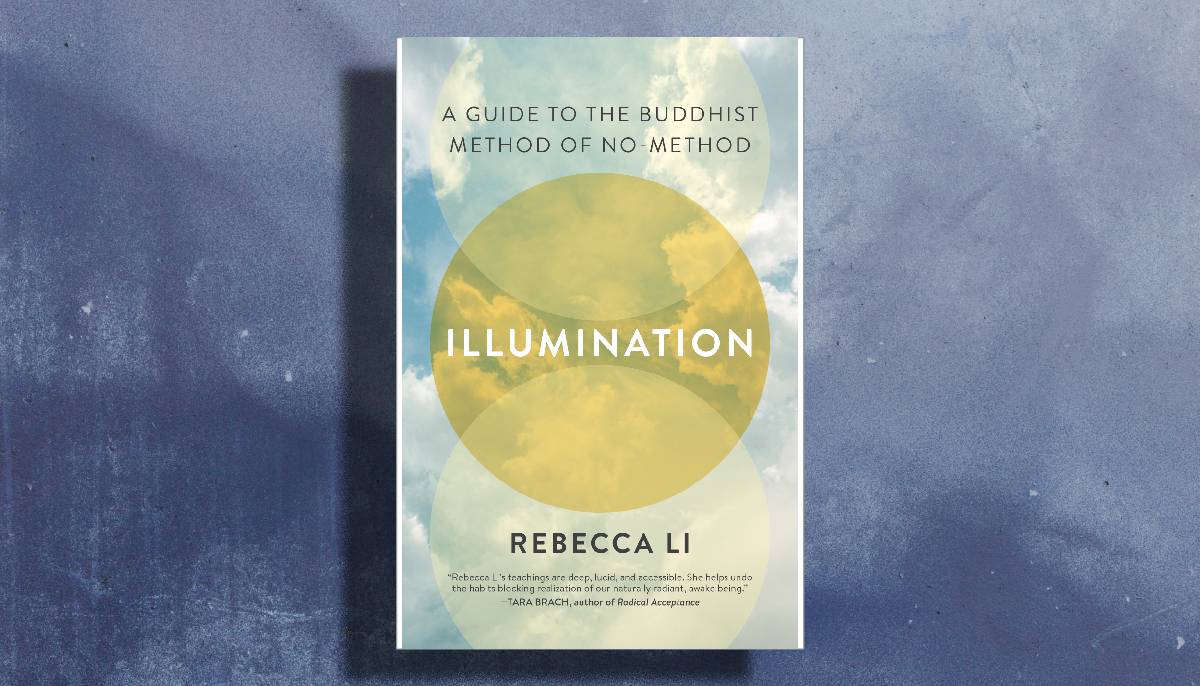This excerpt from Illumination: A Guide to the Buddhist Method of No-Method by Rebecca Li — as reviewed in the Winter 2023 issue of Buddhadharma: The Practitioner’s Guide — is provided courtesy of the publisher, Shambhala Publications. We thank Shambhala for sharing this with Buddhadharma’s readers, and we thank our readers for supporting dharma publishers.
 “Silently and serenely, one forgets all words. Clearly and vividly, it appears before you.” These are the opening lines of Chan Master Hongzhi’s poem “Silent Illumination.” He was pointing to freedom from suffering, clearly seeing and embracing the interconnectedness of all things and the compassion that naturally arises from this realization. The moment we just allow the present moment to be while being fully present, without succumbing to the habits of objectifying the present moment, craving, and aversion—there is no suffering. We are in Silent Illumination. It is not a state of nothingness. Everything exists; the dynamic coming together of causes and conditions of each emerging present moment is clearly revealed.
“Silently and serenely, one forgets all words. Clearly and vividly, it appears before you.” These are the opening lines of Chan Master Hongzhi’s poem “Silent Illumination.” He was pointing to freedom from suffering, clearly seeing and embracing the interconnectedness of all things and the compassion that naturally arises from this realization. The moment we just allow the present moment to be while being fully present, without succumbing to the habits of objectifying the present moment, craving, and aversion—there is no suffering. We are in Silent Illumination. It is not a state of nothingness. Everything exists; the dynamic coming together of causes and conditions of each emerging present moment is clearly revealed.
When we see clearly that the separation between self and others is an idea and not reality, benefiting others becomes no different from benefiting ourselves. In one sentence, Master Hongzhi showed us how to be free from suffering and how we are habituated to getting in the way of our liberation. This means whether we suffer or not is up to us. Realizing this is profoundly liberating and empowering. We can be in Silent Illumination right now—just stop and drop the entrenched habit of reacting with vexations. Chances are you’ll notice that you’re not at ease, that you do not even know that your mind is either craving or rejecting, and that you’re resisting the idea of not reacting. You may think, “What will happen if my mind stops doing what it does?” Try it. You may find yourself freed to be fully here, allowing everything in the moment to be as it is. The entrenched habit of feeling that something is not how it’s supposed to be in the present is not activated. It’s a different way of being.
Silent Illumination is the natural state of being fully human. There is no need to look outside of ourselves to achieve it. It is already here, within each one of us. We just need to wake up and see it, to reconnect with what is already within us at this very moment. This is why the meditation practice in Silent Illumination is called “just sitting.” The method is to abide nowhere and allow the mind to arise, as instructed by Master Huineng (638–713 c.e.), the sixth lineage master in Chan.
In the Tathagatagarbha Sutra there is a story of a boy whose parents sewed a priceless pearl inside his coat. Yet, the boy forgot all about it and as he grew older looked for wealth everywhere. Finding none, he could barely survive. All the while he was in possession of a priceless pearl that he could use to benefit all beings. The pearl in the story refers to our buddha-nature—our natural capacity for wisdom and compassion. It is our capacity to see clearly and act with an appropriate response according to conditions, to see the interconnectedness of all beings, and to love them unconditionally as we see clearly that loving others is no different from loving ourselves. In other words, we each have an innate capacity for wisdom and compassion. We are already fully endowed with this capacity; we are each in possession of this priceless pearl. However, our untrained mind is often too confused and agitated to see this fact and instead we keep looking outward, grasping for what we already possess. This is why Buddhist practice, especially Chan, often involves some form of meditation to train and stabilize the mind to cultivate clarity about how much we get in the way of ourselves.
Meditation in the practice of Silent Illumination is a different way of meditating. For practitioners who started with a method involving a clear object of the mind, such as the breath or counting the breath, it is helpful to understand the difference. Otherwise, you may be inadvertently perpetuating or even strengthening the habits that block you from reconnecting with your buddha-nature instead of unlearning them.
Meditation using the breath to stabilize the mind can help us transition into the practice of Silent Illumination. Since we must breathe to live, the direct experience of the changing sensations of the body with each inhalation and exhalation is a good anchor for maintaining contact with each emerging present moment. We allow the body to breathe naturally, fully experiencing the subtle changing sensations as the diaphragm expands and contracts, air coming in and out of the nostrils, the simple experience of being alive and sitting fully being a breathing body in this space.
As you do this, you will likely notice your mind drifting off, losing contact with the direct experience of the body breathing. It’s not a problem. Make use of that as an opportunity to practice remembering to come back to the direct experience of the changing sensations of the body breathing. There is no need to get frustrated when the mind drifts. Setting the breath as the object to rest the mind allows us to be aware of the movement of the mind. It allows us to notice that the mind, like the body, is not fixed; it’s constantly changing. So, when you notice the mind drifting off, that noticing is awareness. This clarity allows you to choose to bring your attention back to the breath. It doesn’t matter how often the mind drifts; as long as you find your way back to the changing sensations of the body breathing, you are practicing well. When we practice with the breath method this way, the mind settles down.
We can think of the confused and agitated mind like a jar of muddy water. Our habitual tendencies of reacting to the present moment by craving or aversion are movements that shake up the mind, stirring the silt in this jar of water. Resting our attention gently on the changing sensations of the body breathing, moment after moment, is like holding the jar still and allowing the silt to settle on its own. There is no need to do anything to adjust what we believe is disturbing the mind. This only agitates the mind further, like shaking up the jar and stirring up the silt again. As the mind settles, we can see into it more clearly and notice what is going on—the subtle and not-so-subtle ways in which we suffer and cause our suffering.
It is important to correctly understand the function of the breath in stabilizing the mind while cultivating clear awareness of the mind’s habitual tendencies. This can be a tricky transition for practitioners who have been using the breath to concentrate the mind. They are used to focusing on the breath by blocking everything else out. It is a narrowing of our attention to a small area such as the nostrils to focus on the breath. This is an effective way to strengthen concentration, and we are familiar with focusing the mind this way. It is like when we focus on a task, such as working on an essay, by blocking out everything else. You can be oblivious to the fact that the sun has set or that you’re hungry. The mind tenses up to narrow its focus in this highly concentrated state, and that’s why we get quite tired after a while. It is not sustainable to focus the mind in this manner for long periods of time.
With Silent Illumination, we can be fully present and constantly engaged with each task at hand with clarity because Silent Illumination does not involve tensing the mind. Meditating in Silent Illumination is about opening this clear awareness to allow all to be illuminated. When we tense the mind to focus on a narrow area where the breath is felt, we are not allowing the rest of the body, thoughts and emotions, and the environment into our awareness.
To transition into meditating in Silent Illumination, we relax into each emerging present moment, opening our awareness and allowing thoughts and sounds in the environment to be there. For practitioners accustomed to cultivating a highly concentrated mind, this may feel like they have lost their practice. In fact, many practitioners have resisted the instruction to open their awareness because they were convinced that concentrating the mind on only the breath is the right practice. Being able to concentrate is a handy skill, and it can be quite enjoyable to experience the sensations of a concentrated mind in meditation. Training the mind only in this way, however, will not cultivate clear awareness of how we cause suffering to ourselves and others so that we can unlearn these entrenched habits. Concentration alone will not free us from suffering.
Without clarity on our entrenched habits that cause suffering to ourselves and others, we are prone to perpetuate these habits further. Someone who has the habit of being critical, for instance, can become meaner and nastier without being aware of it. Hence, it is helpful to learn to work with the breath method in a gentle way. Instead of holding on to the breath tightly to concentrate the mind by blocking out everything, all we need to do is gently maintain contact with the changing sensations of the body breathing moment after moment. In this way, we are cultivating clear awareness of the entire body. By letting thoughts through, letting them be, and letting them go on their own, we are also cultivating clear awareness of subtle activities in the mind. By allowing sensations such as sound and touch to be experienced fully, we are allowing the environment, such as a car passing by or the room warming up, into our awareness, and thus we allow everything to coexist in each emerging present moment. Practicing this way, the mind can truly settle and become quite still.
From Illumination: A Guide to the Buddhist Method of No-Method by Rebecca Li © 2023 by Rebecca Li. Reprinted in arrangement with Shambhala Publications, Inc. Boulder, CO. www.shambhala.com
For more on the latest dharma books, read this issue’s edition of Buddhadharma on Books. Or see more excerpts and other digital exclusives for Buddhadharma readers here.

